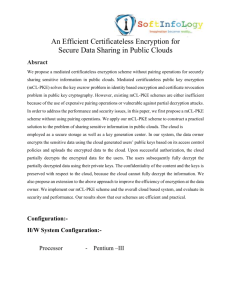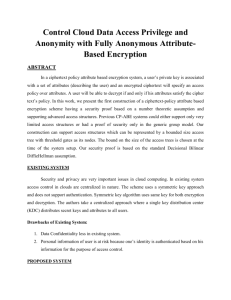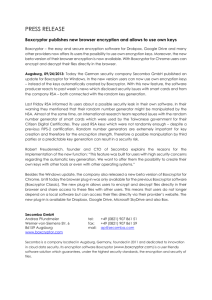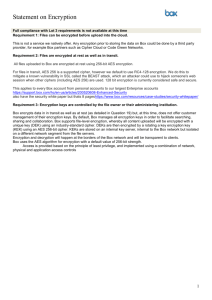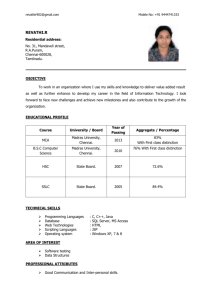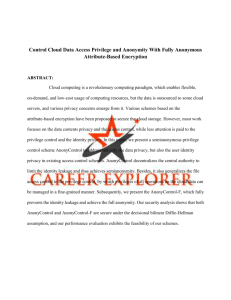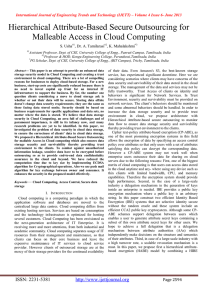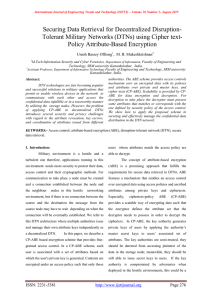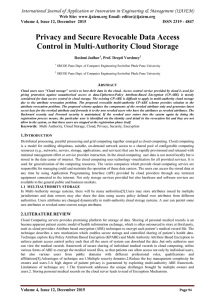Data confidentiality On Health-care Information System Abstract
advertisement
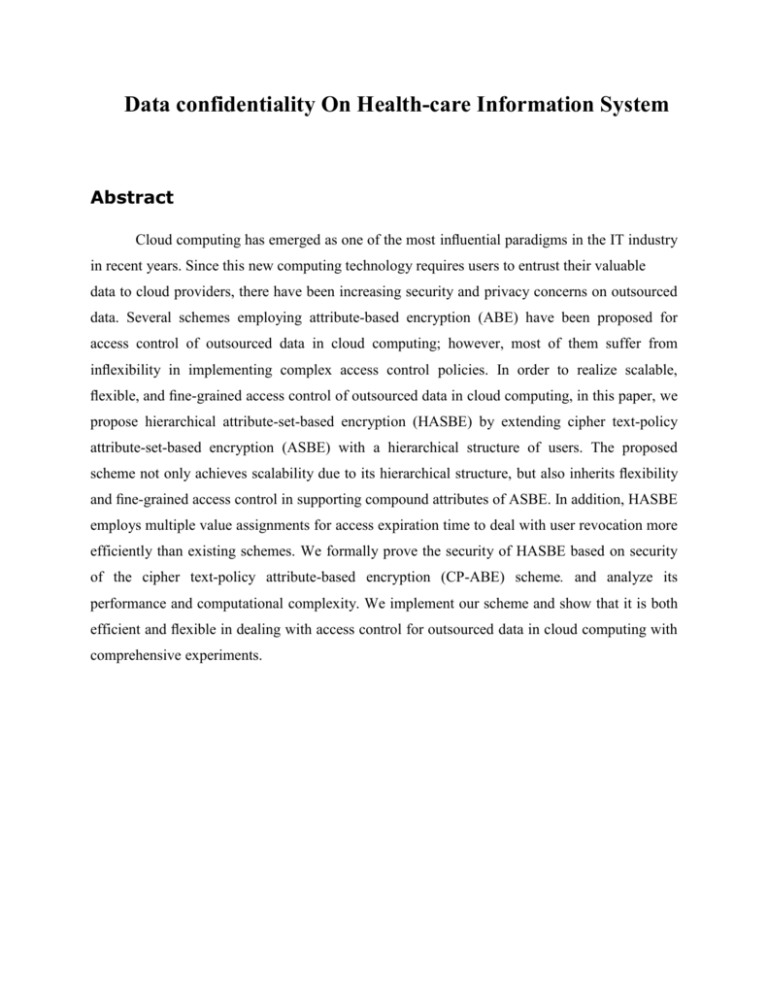
Data confidentiality On Health-care Information System Abstract Cloud computing has emerged as one of the most influential paradigms in the IT industry in recent years. Since this new computing technology requires users to entrust their valuable data to cloud providers, there have been increasing security and privacy concerns on outsourced data. Several schemes employing attribute-based encryption (ABE) have been proposed for access control of outsourced data in cloud computing; however, most of them suffer from inflexibility in implementing complex access control policies. In order to realize scalable, flexible, and fine-grained access control of outsourced data in cloud computing, in this paper, we propose hierarchical attribute-set-based encryption (HASBE) by extending cipher text-policy attribute-set-based encryption (ASBE) with a hierarchical structure of users. The proposed scheme not only achieves scalability due to its hierarchical structure, but also inherits flexibility and fine-grained access control in supporting compound attributes of ASBE. In addition, HASBE employs multiple value assignments for access expiration time to deal with user revocation more efficiently than existing schemes. We formally prove the security of HASBE based on security of the cipher text-policy attribute-based encryption (CP-ABE) scheme. and analyze its performance and computational complexity. We implement our scheme and show that it is both efficient and flexible in dealing with access control for outsourced data in cloud computing with comprehensive experiments. Architecture Algorithm: Cipher text-Policy Attribute-Based Encryption (CP-ABE) Type of identity-based encryption o One public key o Master private key used to make more restricted private keys But very expressive rules for which private keys can decrypt which cipher texts o Private keys have “attributes” or labels o Cipher texts have decryption policies CP-ABE is much more flexible than plain identity-based encryption, in that it allows complex rules specifying which private keys can decrypt which ciphertexts. Specifically, the private keys are associated with sets of attributes or labels, and when we encrypt, we encrypt to an access policy which specifies which keys will be able to decrypt. Existing System In Existing system a HASBE system model, there are multiple owners who may encrypt according to their own ways, possibly using different sets of cryptographic keys. Letting each user obtain keys from every owner whose records she wants to read would limit the accessibility since patients are not always online. An alternative is to employ a central authority (CA) to do the key management on behalf of all record owners, but this requires too much trust on a single authority (i.e., cause the key escrow problem). Key escrow (also known as a “fair” cryptosystem) is an arrangement in which the keys needed to decrypt encrypted data are held in escrow so that, under certain circumstances, an authorized third party may gain access to those keys. These third parties may include businesses, who may want access to employees' private communications, or governments, who may wish to be able to view the contents of encrypted communications. Proposed System We endeavor to study the patient centric, secure sharing of records in HASBE stored on semi-trusted servers, and focus on addressing the complicated and challenging key management issues. In order to protect the personal health data stored on a semi-trusted server, we adopt attribute-based encryption (ABE) as the main encryption primitive. The proposed scheme not only achieves scalability due to its hierarchical structure, but also inherits flexibility and fine-grained access control in supporting compound attributes of ASBE. In addition, HASBE employs multiple value assignments for access expiration time to deal with user revocation more efficiently than existing schemes. We formally prove the security of HASBE based on security of the ciphertext-policy attribute-based encryption (CP-ABE) Using ABE, access policies are expressed based on the attributes of users or data, which enables a patient to selectively share her records among a set of users by encrypting the file under a set of attributes, without the need to know a complete list of users. The complexities per encryption, key generation and decryption are only linear with the number of attributes involved. Advantage 1. Scalability 2. Flexibility 3. Fine-grained access control 4. Efficient User Revocation 5. Expressiveness Modules 1. Registration 2. Upload files 3. ABE for Fine-grained Data Access Control 4. Setup and Key Distribution Modules Description Registration In this module, the cloud computing system under consideration consists of five types of parties: 1. A CLOUD SERVICE PROVIDER, 2. DATA OWNERS, 3. DATA CONSUMERS, 4. A NUMBER OF DOMAIN AUTHORITIES, and 5. A TRUSTED AUTHORITY. The cloud service provider manages a cloud to provide data storage service. Data owners encrypt their data files and store them in the cloud for sharing with data consumers. To access the shared data files, data consumers download encrypted data files of their interest from the cloud and then decrypt them. Each data owner/consumer is administrated by a domain authority. A domain authority is managed by its parent domain authority or the trusted authority. Data owners, data consumers, domain authorities, and the trusted authority are organized in a hierarchical manner. Upload files In this module, users upload their files with secure key probabilities. The owners upload ABE-encrypted RECORD files to the server. Each owner’s record file encrypted both under a certain fine grained model. ABE for Fine-grained Data Access Control In this module ABE to realize fine-grained access control for outsourced data especially, there has been an increasing interest in applying ABE to secure electronic healthcare records (EHRs). An attribute-based infrastructure for EHR systems, where each patient’s EHR files are encrypted using a broadcast variant of CP-ABE that allows direct revocation. However, the cipher text length grows linearly with the number of un revoked users. In a variant of ABE that allows delegation of access rights is proposed for encrypted EHRs applied cipher text policy ABE (CP-ABE) to manage the sharing of RECORDs, and introduced the concept of social/professional domains investigated using ABE to generate selfprotecting EMRs, which can either be stored on cloud servers or cell phones so that EMR could be accessed when the health provider is offline. Setup and Key Distribution In this module the system first defines a common universe of data attributes shared by every PSD, such as “basic profile”, “medical history”, “allergies”, and “prescriptions”. An emergency attribute is also defined for break-glass access. Each RECORD owner’s client application generates its corresponding public/master keys. The public keys can be published via user’s profile in an online healthcare social-network (HSN) There are two ways for distributing secret keys. First, when first using the RECORD service, a owner can specify the access privilege of a data reader in her PSD, and let her application generate and distribute corresponding key to the latter, in a way resembling invitations in Google Doc. Second, a reader in PSD could obtain the secret key by sending a request (indicating which types of files she wants to access) to the RECORD owner via HSN, and the owner will grant her a subset of requested data types. Based on that, the policy engine of the application automatically derives an access structure, and runs keygen of KP-ABE to generate the user secret key that embeds her access structure. System Requirements: Hardware Requirements: • System : Pentium IV 2.4 GHz. • Hard Disk : 40 GB. • Floppy Drive : 1.44 Mb. • Monitor : 15 VGA Colour. • Mouse : Logitech. • Ram : 512 Mb. Software Requirements: • Operating system : - Windows 7 Ultimate (32-bit) • Coding Language : ASP.Net with C#. • Front End : Visual Studio 2010 Professional • Data Base : SQL Server 2008
